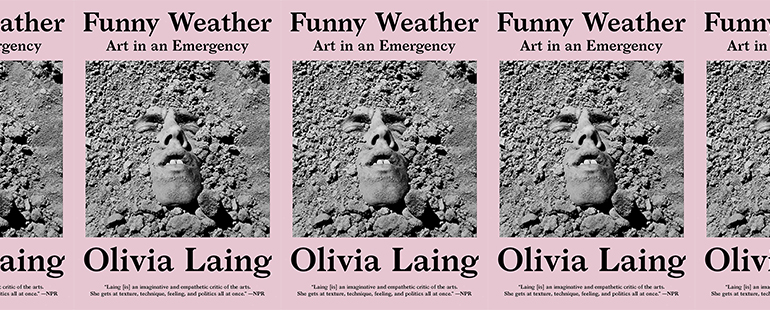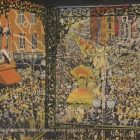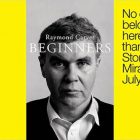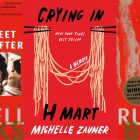The Importance of Writing About Art

“Can art do anything, especially in periods of crisis?” This is the question that drives Olivia Laing’s collection of criticism, Funny Weather: Art in an Emergency. When calls for social action are urgent, the labor of the imagination can seem frivolous—at worst, an artwork is irrelevant; at best, it’s only a slant approach to the pursuit of justice. And if art itself is peripheral to the work a community really needs, I wonder, how much more removed is art criticism? How can those of us who write about books and songs and paintings justify our efforts? In a provocative series of essays, reviews, and artist profiles, Olivia Laing makes a case for art’s slow, subtle efficacy. And in her acuity as a critic, she demonstrates that not only art, but writing about art, can be a powerful agent of social change.
Everything Laing writes bears the gravitas of her social consciousness. In these essays, she’s sick over the rejection of refugees at the borders, and over violence against queer and Black communities. But she doesn’t focus the energy of her prose on bans and brutality so much as on their opposites: welcome and liberation. She’s drawn to artists of “resistance and repair”—those “who look with sharp eyes at the societies they inhabit but who also propose new ways of seeing.” Among them: Jean-Michel Basquiat, whose graffiti playfully offered alternatives to corporate oppression; David Wojnarowicz, whose work spoke amid the silencing of the gay community in 1980s New York; and David Hockney, who made what he called “propaganda for queer love.” She loves these artists because their work transfigures suffering into joy and poverty into abundance, helping us to imagine, to hope in, and to work for new ways of being human together.
It’s difficult to envision realities beyond what’s already perceptible, especially when the binaries that define our politics leave so little room for the imagination. The artists written about in Funny Weather (2020) invite us to see the world as they imagine it, and they do so not with the coercive forces of ideology, but with the persuasion of emotional experience. The capacity to surface emotion is one of art’s unique virtues. How many times has my throat gone tight for a folk song’s timbre, or my heart raced over a certain shade of blue? And I couldn’t tell you why, exactly; the experience resists explanation. Art has the capacity to bypass our biases with expressions of beauty or the grotesque that appeal to us not with language or logic but to our affective and sensing selves.
Thus the critic’s task is a paradox: to translate into words works that were created to say what words cannot. In fact, many of the artists that interest Laing expressly set out to defy the limits of language. Included in Funny Weather is a profile on the minimalist painter Agnes Martin. “It isn’t easy to catch the working of these paintings in words,” Laing writes about Martin’s muted canvases. “They aren’t to be read, but rather responded to, enigmatic triggers for a spontaneous upwelling of pure emotion.” So how does Laing make reading about paintings worth our while, when, as she puts it, “the paintings are the thing”? She replicates the emotional potency of the work: its aesthetic intrigue and its personal testimony.
When Laing describes a work of art, she vividly recreates what can be perceived with the senses to evoke the work’s aesthetic intrigue. What does it look like, feel like, sound like? Staying on the surface, she makes room for each reader’s unique emotional response, and the aesthetic force of the work is not lost. Take, for example, these lines about Rachel Kneebone’s surreal porcelain sculptures: “Kneebone builds towers, or maybe pits, of body parts: hundreds upon thousands of elegantly extended, gleaming legs, triumphant and appalling. You look and see a flower; you look again and see a cock. What are these excrescences, that might be mineral or animal or vegetable, that might be melted wax or human hands?” Laing invites us into the viewing experience using the second person (“you look . . . you look again”) and captures the visual ambiguity of these shapes (“or . . . or . . . or”). She brings us into the moment of encounter—the double-take we’d do were we standing beside her in the gallery. As if up close with this fleshy porcelain, I feel at once squeamish and seduced. Suddenly I’m rattled by the violence in the news that deems the human body disposable, and I’m all fired up about the grace and dignity of the human form.
When I read Laing on Georgia O’Keefe’s Black Place paintings, I notice her translation of color: “the serried hills smashed into shards of grey and puce, bifurcated by yolk-coloured cracks or spills of oily black.” Though I’ve never seen these paintings, I can vividly imagine their tones, and the eggs and the oil feel to me earthy, elemental. Then there are Laing’s nouns and verbs—smashed, shards, crack—which evoke an emotional tenor of ruggedness and severity. Suddenly I’m not in an armchair in my living room; I’m with O’Keefe in the desert, and I’m awestruck. Seeing the world as O’Keefe sees it, I wonder what it means to be a woman in a man’s art world—what grit is required to be undaunted by giant desert skies and impossibly arid land.
Critic Cleanth Brooks coined the term heresy of paraphrase, warning against abstracting a poem from the experience of reading the poem by trying to explain its meaning. Though Laing does offer her own readings of artworks, she sidesteps the hazards of paraphrase by focusing less on her own interpretation than on the work’s atmosphere, doing the best she can with the written word to allow readers their own experience of the sensory material. If an artwork persuades by its aesthetic intrigue, then this approach to criticism has the capacity to advance the persuasion that the art itself begins.
Just as Laing ushers us into the feeling of an artwork, she also suggests how it might feel to be in a room with the artists themselves. The tone of each essay is notably different from the one before, evoking the voice of its subject. When Laing writes on Basquiat, she’s cool, casual. She recalls the East Village shifting from a “burnt-out wasteland” to the hub of an “art boom”; she calls Basquiat a “down-and-out prodigy,” “flipped . . . from hungry outsider to hot property.” She closes the essay with Basquiat’s own words: “Yeah, boom, for real.” There’s a hip-hop rhythm to these monosyllables—burnt-out, boom, down-and-out, flipped, and hot—and while I read I feel I’m eavesdropping on artist banter in a studio on the Lower East Side. When Laing writes on Martin’s esoteric abstractions, her diction is esoteric: she observes Martin’s “salubrious environs,” recalls the “grandeur of scale and grave beauty” of her early canvases, and lauds “the luminous work of her maturity.” She describes Martin as monastic and mystical, and captures these attributes in the prose. Through diction, Laing brings us into dialogue with artists, translating something of the personal testimonies conveyed in their work. In this, I discover something about the point of writing about art: We write to keep a conversation going.
A conversation in which two people share their own experiences can be far more politically persuasive than a slogan or manifesto. Likewise, an artwork that bears the testimony of the artist—his experience of oppression, the weight of her grief—can be a powerful agent of provocation. It can change minds. “Really the point of art for me was that I wanted to carry on talking and thinking with other people,” sculptor Sarah Lucas tells Laing. Laing observes that Lucas, whose uncanny sculptures reimagine femininity, sets out to foster “an ongoing, free-moving conversation about ideas.”
All of the artists in Funny Weather excite conversation with the radical nature of their work. Joseph Cornell’s assemblage—fantastical scenes confined within boxes—provokes discussion about freedom and constraint. Maggie Nelson’s genre- and gender-bending memoir The Argonauts invites new thinking about sex and reproduction. Robert Rauschenberg’s eclectic combines, which deem no material unworthy of inclusion, prompt questions about democracy. As Laing illuminates these works for me, I become curious about the artists’ questions and sympathetic to their perspectives, eager to participate in the conversation they’ve begun.
If art begins a conversation, criticism continues the conversation. And we need sustained conversation because dialogue doesn’t often prompt sudden change. It can take me years of interaction with a neighbor—small talk across the yard, patient listening over midday coffee, ongoing, uncritical observation—before I begin to move through the world bearing my neighbor’s perspective in mind. Laing sees “paint as a way of entering and becoming someone else.” I’m convinced that the slow erosion of egotism through interpersonal exchange—be it face-to-face conversation or an artist’s painted testimony viewed in a gallery three decades on—is more impactful than a headline or op-ed. The news moves at a dizzying pace, leaving little time to envision that our world could be more generous, more generative than it is now. Art offers “a different kind of time frame,” Laing says, “in which it might be possible both to feel and to think, to process the intense emotional impact of the news and to consider how to react, perhaps even to imagine other ways of being.”
Laing’s writing is accessible enough to engage the reader in ongoing conversation. At turns academic, it’s never so dense as to feel exclusive; any scholarly prose is leavened by pop diction and strings of lyrical sentences. At times Laing is downright chatty, as when she recalls a Marc Hundley print that was “so lovely I wanted to steal it.” When I opened the book, I was unfamiliar with many of the artists she studies, but in reading, I feel welcome—into artists’ lives, into their studios, into the texture and tenor of their compositions. I haven’t studied art history and I don’t make visual art, yet I feel Laing is inviting me to participate in the dialogue she’s generating. Welcome is a theme in her work. She’s against fences, thinks walls are prisons. She’s for openness—the open skies of O’Keefe’s deserts, the open canvas of Martin’s grids. She’s for the open mind, the open door. “Is there enough room?” she asks. “It feels like yes.”
The best criticism introduces us to artists we might not have known and makes us care about them. It amplifies artists’ voices, and if we’re talking about Laing, we’re talking about voices from the margins. She recalls the poster image for David Wojnarowicz’s film Silence=Death: a striking self-portrait in which the artist’s mouth is sewn shut. “If silence equals death, the biting slogan of Aids activists, then part of the work of resistance is to make the people who are being silenced visible,” she writes. Wojnarowicz did so in his art—a photographic record of a plagued and grieved community. Laing does so by writing about Wojnarowicz’s art. And here I am, writing about writing about Wojnarowicz’s art. The conversation continues.
The work of which art is capable in the face of injustice is slow-going. The news moves quickly; cultivating a hopeful imagination takes time. To envision possibilities beyond what we already know requires a plausibility structure erected by sustained conversation in a community of others who are willing to listen, to have their minds changed, to peer out and glimpse what’s taking shape beyond what’s already visible, artist and critic and reader together in the looking. “Is art resistance?” Laing asks. “Can you plant a garden to stop a war? It depends how you think about time. It depends what you think a seed does, if it’s tossed into fertile soil. But it seems to me that whatever else you do, it’s worth tending to paradise, however you define it and wherever it arises.”
This piece was originally published on August 26, 2021.



